Where is the ventilation hose and its advantages
For the organization of ventilation in the premises of various types using the appropriate equipment and accessories. The better it is chosen, the better it is possible to create an airing system. In our case, it will be about what is a flexible ventilation sleeve made of aluminum.
There are also products from plastic, fabric, and also other materials.
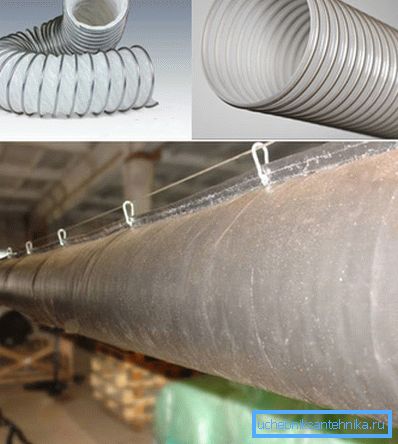
Purpose
Flexible hoses for ventilation are actively used for:
- rapid removal of smoke;
- removal of dust particles;
- removal of exhaust air from the premises;
- removal of various gases and vapors;
- suction and discharge into special bags of abrasive dust, conventional chips and sawdust;
- work with different granular materials used in agriculture, chemical, woodworking and other industries.
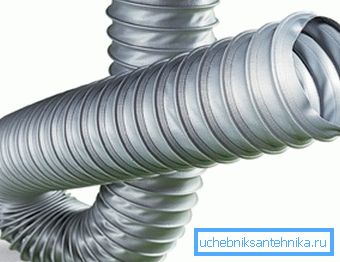
Such high-quality products were able to prove themselves well in practice, so many companies and organizations use them for repair, refurbishment and installation work.
Standard type ventilation hoses are widely used in:
- various ventilation and air conditioning systems;
- vacuum systems;
- industrial vacuum cleaners;
- for the inflow and outflow of cold and hot air;
- car repair shops for quick exhaust gas exhaust and various fumes.
Convenient and practical flexible hose for ventilation today has become the key to safety and high functionality of such systems.
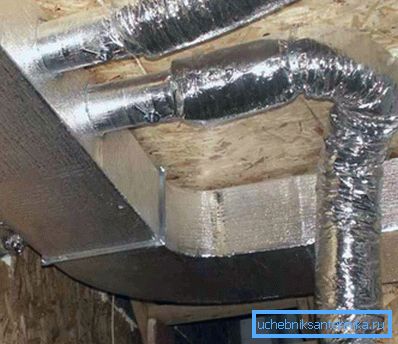
Tip: do not save on the overall quality of products, as only the highest quality can provide normal work, and their life will be long.
Benefits
When choosing ventilation hoses, it is necessary to know about their advantages, which in some respects exceed rigid air ducts:
- Allow to significantly reduce vibration, which "dissolves" due to the softness of the material. Such properties even have a non-insulated element of a flexible type, which is not capable of supporting vibration waves, which often occur with the operation of a fan or other similar devices.
- Low weight, so the channels are easier to install and this does not need to put considerable physical effort. They are convenient for laying air ducts above suspended ceilings, their small mass can not damage or destroy the ceiling structure.
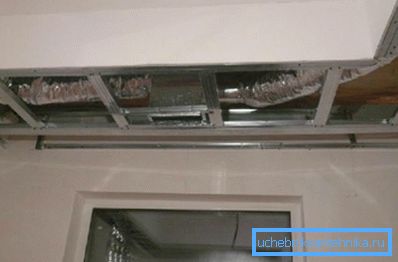
- Easy installation of elements, where you just have a couple of clamps. The price of products and fasteners is quite affordable to a wide range of users.
Tip: to increase the length of the flexible duct, use extensions made of galvanized steel.

- Convenient design, so you can do without corner bends. Due to the length, which can reach 10 m, you can not use butt inserts.
- Properly installed flexible ventilation channels will not create a lot of noise during operation, besides, the circular cross section is optimal for the ventilation system.
- Warming channels is made without additional effort and cost of materials that are evenly spaced along the surface of the duct.
- Long service life, despite the minimum thickness of aluminum sheet (less than 1 mm).
Kinds
| Insulated | Air ducts of this type are produced already insulated, which prevents freezing inside the accumulated condensate. They can retain heat from pumped air currents, if provided for by the design of the ventilation system. |
| Frame | These models have a wire frame up to 1.4 mm thick, on which a layer of aluminum foil is spirally wound. |
| Solid | They are also called frameless. Made of solid thin aluminum sheet. Can stretch, which is convenient when installing. |
Any type of manufacturers are trying to vary the different diameters, so that consumers can choose the most suitable for them. Today, the maximum is 500 mm, the minimum is 100 mm.
Operating rules
Below we offer you to familiarize yourself with the general recommendations of experts who will be useful to you during the installation and further use of elements:
- When installing, a flexible air duct should be stretched to the maximum length in order to prevent loss of air pressure inside. In particular, this parameter is crucially important for natural ventilation systems.
- Do not allow sagging and sagging, this is especially important when creating ventilation channels in the interceiling space.
- If it is necessary to rotate a flexible duct, its radius must be made as large as possible, then the air pressure drop in the system will be minimal. This will also make it possible to reduce the noise level when the ventilation system is operating.
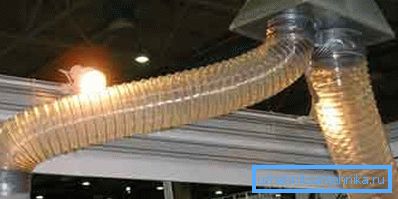
- Do not forget to safely ground the flexible duct. Because of the constant passage of air, such structures accumulate static electricity.
- For the passage of a flexible ventilation channel through the brick walls, it is desirable to prepare a special adapter or a metal sleeve.
- The softness of the structure is the only weak point due to which such air ducts can be damaged. Therefore, when installing it is necessary to observe accuracy, as well as to conduct thorough checks during commissioning works.
- The instruction forbids to install the ventilation hoses vertically to a height exceeding 2 floors.
- Do not forget that all flexible structures have a certain limit for negative and high temperatures.
- Do not install flexible air ducts below ground level, through the floor and direct contact with the ground.
Output
Flexible air ducts are a good alternative to tough ones, but you need to know that in some cases they are not recommended for use. It is necessary to consider the regulatory rules that will avoid wasting money and trouble.
The video in this article will help you find additional information on this topic.